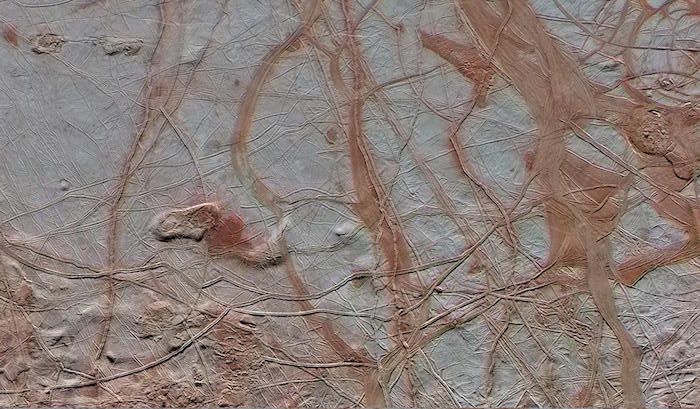Once a month here on the Molten Sulfur Blog, I run content taken from our book Archive: Historical People, Places, and Events for RPGs. This post is one of eighty entries in Archive, each more gameable than the last!
This post is brought to you by beloved Patreon backer Joel Dalenberg. Thanks for helping keep the lights on! If you want to help keep this blog going alongside Joel, head over to the Patreon page – and thank you!

Europa
The Ice Moon
Europa is the sixth moon of the planet Jupiter. Its surface is a sheet of solid ice, criss-crossed with cracks and fractures. It’s about the size of Earth’s moon. Europa has intrigued astronomers since they first suspected that a vast ocean of liquid water might be hiding underneath the moon’s icy surface. And where there is water, there might be life.
Standing on the surface of Europa, the terrain is rugged: hills, valleys, and sharp ridges. It bears a striking resemblance to rocky landscapes on Earth, except none of the mountains are particularly tall and everything is made of ice. The gravity is one-seventh that on Earth, so your bounding steps will take you far, provided you don’t slip on the steep ice slopes. The sky above is black and starry. The same side of Europa always faces Jupiter, and on that side, Jupiter appears in the sky five hundred times larger than our moon appears on Earth. The surface is as dangerous as it is beautiful. It’s unimaginably cold. There’s almost no atmosphere. And Jupiter emits enough radiation to kill you in a single day.
Europa’s surface is always changing. Thick islands of ice jostle for position, rafting across the countryside over years. New cracks in the ice form and fuse. Water leaks up from below through fissures and gaps and freezes on the surface. The resulting furrows look as though they were made by a giant’s plow. The color, too, is inconsistent. Fresh powder thrown up by asteroid impacts paints some parts of Europa snow white. Other parts are stained brown or red by weird salts in the water bubbling up from the ocean beneath. Even the ‘little’ stuff is alien. Geysers have been observed spraying salt water 120 miles high. And the equator might be covered in 30-foot ice spikes; we’d need to get closer to check.
The ocean beneath the ice is poorly understood. Since we haven’t been there to check, scientists have to use little clues like fluctuations in Europa’s magnetic field to infer what’s down there. There’s a lot of room for error. We don’t even know how thick the ice is. Estimates range from less than 700 feet to more than 20 miles. There’s some evidence there might be shifting ice caves – even vast ice lakes! – between the surface and the ocean. It also looks like the ice inside the sheet can move, with warmer ice chunks as much as five miles across rising towards the surface through the colder ice like blobs in a lava lamp. The ocean beneath the ice might be about sixty miles deep, thirty times deeper than our own ocean.
But what about life? If Europa is anything like Earth, there could be hydrothermal vents on the seafloor: fissures in the ocean bottom where volcanically-heated, chemical-rich water spews out. On our planet, these places are havens for life. They might be on Europa, too. On the other hand, if there’s life on Europa, it might be found clinging to the underside of the ice sheet, or even floating (or swimming!) freely in the ocean. Without so much as a water sample, there’s no way for us to know. But if any place in our solar system besides Earth has life, Europa is the likeliest bet.
Europa in Play
In a campaign, your party could be sent to explore the icy ocean of a world like Europa. Perhaps space industrialists suspect some of the weird salts dissolved in the ocean might be valuable. The PCs are hired to retrieve a water sample, which the industrialists will use to determine if they should build a mining station. Or maybe the PCs are forced to crash-land on this bizarre world. Geysers and ice spikes could complicate the party’s landing. To get to the ocean, a submersible might be handy, though tight corridors might force the PCs to get out and swim in their spacesuits. The party could discover all manner of underwater dungeons, with endless peril caused by the shifting ice, and maybe even some hostile sea creatures. Enemies – either space bandits or alien locals – might stage ambushes in the tunnels. If the PCs are outmatched and try to flee towards the surface, a slab of ice might shift to block the path they took down. The PCs will have to find a new route back, and their pursuers probably know the area better than they do.






